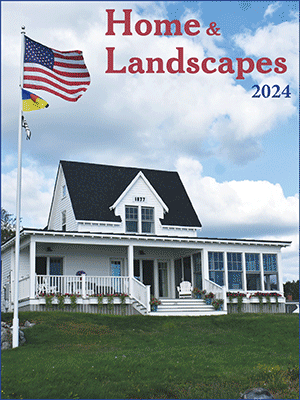Forum on east side changes draws crowd
There were plenty of comments on the planned changes to the marine/water dependent district on Atlantic Avenue at the April 25 Boothbay Harbor Planning Board meeting. As the board had hoped, the public forum nearly filled the entire firehouse.
Chair Bill Hamblen ran through the advisory workgroup’s recommendations. He first shared the workgroup’s vision statement which supports mixed uses including the district’s current uses in addition to hotels, shops and various forms of limited residences all with less density compared to the Downtown Business District.
Hamblen defined the proposed zoning policy as mixed use, continuing current marine and water dependent uses, and implementing high water setbacks of 25 feet except for water-dependent uses, which would remain at a zero-foot setback, view corridors of 20 feet for lots with over a 10- foot frontage, common wall residences at present town-wide density requirements (six units per acre), 2,500-square-foot minimum lot size for common wall residences, allowing lots in common ownership to be treated as contiguous for common wall residences, setting non-residential minimum square footage requirements to 2,000-square feet, permitting new construction heights of 35 feet or two-and-a-half stories, and requiring impact fees for new common wall residence construction. The fees would be 5 percent of construction costs.
Boothbay Harbor resident Susan Craig shared that she asked the committee that changed the district in the 1980s its reason for doing it. Craig said members responded that the move was a knee-jerk reaction to the creation of Carousel Condominiums.
“I wanted to learn if the reasons that existed then were still valid today,” said Craig. She said that without the restructuring of the district, properties like Sea Pier and Boothbay Lobster Wharf would likely be condominiums today.
Bill Logan, a selectman during those changes, said the changes were not just a reaction to Carousel Marina, but a reaction to the rate condominiums were going up then.
“It was to stop and take a break, plan, and think about it. Unfortunately, it lasted 30 years and maybe that’s a good thing because the town wanted to see … how those changes affected development. Now we’ve had a chance to see it. You see it in the condition of those properties.”
Craig reminded the board, Boothbay Lobster Wharf owner Tom Philbrick alluded to the possibility of one day selling to developers intending to invest in interests apart from working waterfront activities.
Philbrick later clarified he meant if the lobstering industry were to fail, he would not want to be forced to hold onto a property that is not going to provide. “If this lobster business doesn’t make it and follows suit like all those other fisheries including scallops, there’s going to be a problem … If we’re bound to keep (our property) as a working waterfront and there’s nothing to land there, what do we do? We have to get creative.”
Craig suggested residents possibly band together to purchase the Cap’n Fish’s property to preserve it as a resource and point of access for residents, fishermen and guests of the region. Craig said she and her husband would be more than willing to donate and to assist in the fundraising.
Boothbay Harbor resident Jean McKay said she and her husband Bob sail every year to Belfast to enjoy its well-preserved waterfront with excellent public access. “They have summer fairs there, fireworks, they have parties. It’s just beautiful,” said McKay. “We’re going to have condos. Come on …”
McKay implored residents to consider Craig’s idea.
Several residents opposed raising the height of newly constructed buildings to 35 feet. Steve Madden, owner of Mung Bean on Townsend Avenue, asked the board why it decided on 35 feet.
Hamblen explained, with other districts already having 35-foot height limits, the board felt raising it in the east side district would show more consistency. The board also would like to revisit the Downtown Business District height limit with that mindset, as current rules allow a total height of 36 feet, Hamblen said.
“Thirty-five is the state standard in shoreland zones. We are under that … Frankly, it will allow more flexibility. The key thing in my mind is that the two-and-a-half story gives you gabled roofs and a crenulated skyline instead of block buildings.”
East side resident and owner of Joy to the Wind Gallery John Seitzer, a vocal opponent of the zoning changes throughout the process, said if they pass, he still looks forward to doing business with the current developer, Paul Coulombe, though they may not agree on many issues.
“I’d like to see the working waterfront be more safe, but I guess I would rather see all of the uses currently (in use) on the east side be allowed … That’s something that I would vote for. However, I have to say there are some things I am not in favor of.”
Seitzer named the height change asking the board to wait until they decide to visit the issue throughout the town in its entirety. He added that the current zoning requirements of multifamily housing, 500 feet from the highwater mark, should be maintained. Finally, Seitzer pointed out a redundancy in the language of the proposed zoning policy which Hamblen acknowledged and made a note to address in the next planning board meeting.
Julie Roberts, owner of Boothbay Harbor business Coastal Popcorn, cited declining school enrollment and increased registration for free or reduced lunches in schools as evidence of the decline in population and economy of the region. Roberts proposed introducing multifamily housing to help attract families because, she said, limiting developers to hotels and restaurants would increase inactivity during off peak months.
“We must fight tooth and nail to be able to compete with Bar Harbor, Kennebunkport, Ogunquit and other great places,” said Roberts. “We are none of these places, but we have no choice but to keep up with them to survive.”
Southport resident – and hopeful soon-to-be-resident of Boothbay Harbor – Tom Myette thanked the advisory workgroup and planning board for making the process about facts rather than personality or emotions.
Said Myette, “Fifty years ago almost to this day a gentleman drove up from Hartford, Connecticut, in a Rolls Royce, and decided to build on a piece of property… Rocktide. The town welcomed him and I think the town has benefited from that property for a very long time. And what we’re seeing now is curiously very, very similar.”
Event Date
Address
United States

























